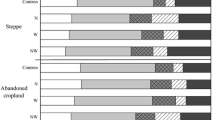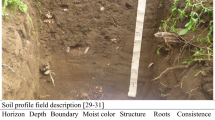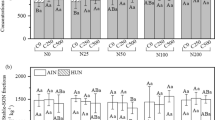Abstract
Purpose
The classical nitrogen (N) cycling model has provided good understanding of inorganic N dynamics in agricultural soils, but largely ignores organic N available to plants. The ability of numerous crop plant species to take up and use amino acids underlines the importance of this N pool in agricultural systems; therefore, the soil free amino acids (FAA) pool was quantified in soils under organic (organic soil) and conventional (conventional soil) management after addition of different types of fertilizer.
Materials and methods
After application of the same amount of N as urea, alfalfa, rice straw, or compost in the organic soils and urea or alfalfa in the conventional soils, water-extractable amino acid composition and concentrations, and inorganic and microbial N were measured during a 56 day soil incubation.
Results and discussion
Alanine, glutamic acid, glycine, isoleucine, leucine, phenylalanine, serine, tryptophan, and valine were the most abundant soil FAA. Organic and conventional soils did not significantly differ in their soil FAA composition and concentrations. Urea significantly modified FAA composition, but only in organic soils, suggesting that urea disrupts microbial structure and/or metabolic pathways in organic soils. Alfalfa and compost did not alter FAA composition and concentrations, indicating that any pulses of amino acids from these materials are short lived. On the contrary, straw significantly increased FAA concentrations after 15 days, coinciding with an increase in microbial biomass N.
Conclusions
FAA concentrations remain low and have a largely constant composition in both organic and conventional soils; however, the addition of some fertilizers can significantly alter FAA composition and concentrations, which may affect the importance of amino acid N in the total N budget of plants. These findings warrant further research into the mechanisms controlling soil FAA composition and concentration in agricultural soils.



Similar content being viewed by others
References
Altamura MR, Robbins FM, Andreaotti RE et al (1967) Amino acids, related compounds, and other nitrogenous substances found in cultivated mushroom, Agaricus campestris. J Agric Food Chem 15:1040–1043
Apostel C, Dippold M, Glaser B, Kuzyakov Y (2013) Biochemical pathways of amino acids in soil: assessment by position-specific labeling and 13C-PLFA analysis. Soil Biol Biochem 67:31–40
Berthrong S, Finzi A (2006) Amino acid cycling in three cold-temperate forests of the northeastern USA. Soil Biol Biochem 38:861–869
Boldyrev AA (2007) Carnosine and oxidative stress in cells and tissues. Nova Publishers, New York
Chantigny MH (2003) Dissolved and water-extractable organic matter in soils: a review on the influence of land use and management practices. Geoderma 113:357–380
Clarke KR (1993) Non-parametric multivariate analyses of changes in community. Aust J Ecol 18:117–143
Craine JM, Morrow C, Fierer N (2007) Microbial nitrogen limitation increases decomposition. Ecology 88:2105–2113
Crecchio C, Curci M, Mininni R, Ricciuti P, Ruggiero P (2001) Short-term effects of municipal solid waste compost amendments on soil carbon and nitrogen content, some enzyme activities and genetic diversity. Biol Fertil Soils 34:311–318
El-Naggar A, de Neergaard A, El-Araby A, Høgh-Jensen H (2009) Simultaneous uptake of multiple amino acids by wheat. J Plant Nutr 32:725–740
El-Naggar A, Rasmussen J, Neergaard A et al (2010) Effect of plant species and temperature on amino acid release from plant material. Agron Sustain Dev 30:679–688
Finlay RD, Ek H, Odham G, Söderström B (1988) Mycelial uptake, translocation and assimilation of nitrogen from 15N-labelled ammonium by Pinus sylvestris plants infected with four different ectomycorrhizal fungi. New Phytol 110:59–66
Friedel JK, Scheller E (2002) Composition of hydrolysable amino acids in soil organic matter and soil microbial biomass. Soil Biol Biochem 34:315–325
Ge T, Nie S, Wu J, Shen J, Xiao H, Tong C, Huang D, Hong Y, Iwasaki K (2010) Chemical properties, microbial biomass, and activity differ between soils of organic and conventional horticultural systems under greenhouse and open field management: a case study. J Soils Sediments 11:25–36
Geisseler D, Horwath W (2008) Regulation of extracellular protease activity in soil in response to different sources and concentrations of nitrogen and carbon. Soil Biol Biochem 40:3040–3048
Geisseler D, Horwath WR, Doane TA (2009) Significance of organic nitrogen uptake from plant residues by soil microorganisms as affected by carbon and nitrogen availability. Soil Biol Biochem 41:1281–1288
Geueke B, Kohler H-PE (2007) Bacterial beta-peptidyl aminopeptidases: on the hydrolytic degradation of beta-peptides. Appl Microbiol Biotechnol 74:1197–1204
Harrison KA, Bol R, Bardgett RD (2007) Preferences for different nitrogen forms by coexisting plant species and soil microbes. Ecology 88:989–999
Hartman WH, Richardson CJ (2013) Differential nutrient limitation of soil microbial biomass and metabolic quotients (qCO2): is there a biological stoichiometry of soil microbes? PLoS One 8:e57127
He ZQ, Senwo ZN, Zou HX et al (2014) Amino compounds in poultry litter, litter-amended pasture soils and grass shoots. Pedosphere 24:178–185
Hofmockel KS, Fierer N, Colman BP, Jackson RB (2010) Amino acid abundance and proteolytic potential in North American soils. Oecologia 163:1069–1078
Jämtgård S, Näsholm T, Huss-Danell K (2010) Nitrogen compounds in soil solutions of agricultural land. Soil Biol Biochem 42:2325–2330
Jones DL (1999) Amino acid biodegradation and its potential effects on organic nitrogen capture by plants. Soil Biol Biochem 31:613–622
Jones DL, Darrah RR (1994) Amino-acid influx at the soil-root interface of Zea mays L. and its implications in the rhizosphere. Plant Soil 163:1–12
Jones DL, Hodge A (1999) Biodegradation kinetics and sorption reactions of three differently charged amino acids in soil and their effects on plant organic nitrogen availability. Soil Biol Biochem 31:1331–1342
Jones DL, Shannon D, Junvee-Fortune T, Farrar JF (2005) Plant capture of free amino acids is maximized under high soil amino acid concentrations. Soil Biol Biochem 37:179–181
Kielland K (1994) Amino acid absorption by arctic plants: implications for plant nutrition and nitrogen cycling. Ecology 75:2373–2383
Kielland K, McFarland JW, Ruess RW, Olson K (2007) Rapid cycling of organic nitrogen in Taiga forest ecosystems. Ecosystems 10:360–368
Komeda H, Asano Y (2005) A DmpA-homologous protein from Pseudomonas sp. is a dipeptidase specific for beta-alanyl dipeptides. FEBS J 272:3075–3084
Lipson D, Näsholm T (2001) The unexpected versatility of plants: organic nitrogen use and availability in terrestrial ecosystems. Oecologia 128:305–316
Mafongoya PL, Barak P, Reed JD (2000) Carbon, nitrogen and phosphorus mineralization of tree leaves and manure. Biol Fertil Soils 30:298–305
McLain JET, Martens DA (2005) Nitrous oxide flux from soil amino acid mineralization. Soil Biol Biochem 37:289–299
Mooshammer M, Wanek W, Hämmerle I et al (2014) Adjustment of microbial nitrogen use efficiency to carbon:nitrogen imbalances regulates soil nitrogen cycling. Nat Commun 5:3694
Näsholm T, Ekblad A, Nordin A et al (1998) Boreal forest plants take up organic nitrogen. Nature 392:914–916
Näsholm T, Huss-Danell K, Högberg P (2000) Uptake of organic nitrogen in the field by four agriculturally important plant species. Ecology 81:1155–1161
Näsholm T, Huss-Danell K, Högberg P (2001) Uptake of glycine by field grown wheat. New Phytol 150:59–63
Owen A, Jones DL (2001) Competition for amino acids between wheat roots and rhizosphere microorganisms and the role of amino acids in plant N acquisition. Soil Biol Biochem 33:651–657
Øyvind H, Harper DAT, Ryan PD (2001) PAST: Paleontological statistics software package for education and data analysis. Palaeontol Electron 4:1–9
Reeve JR, Smith JL, Carpenter-Boggs L, Reganold JP (2008) Soil-based cycling and differential uptake of amino acids by three species of strawberry (Fragaria spp.) plants. Soil Biol Biochem 40:2547–2552
Reeve JR, Smith JL, Carpenter-Boggs L, Reganold JP (2009) Glycine, nitrate, and ammonium uptake by classic and modern wheat varieties in a short-term microcosm study. Biol Fertil Soils 45:723–732
Rinnan R, Bååth E (2009) Differential utilization of carbon substrates by bacteria and fungi in tundra soil. Appl Environ Microbiol 75:3611–3620
Rothstein DE (2010) Effects of amino-acid chemistry and soil properties on the behavior of free amino acids in acidic forest soils. Soil Biol Biochem 42:1743–1750
Rovira P, Kurz-Besson C, Hernàndez P, Coûteaux MM, Vallejo VR (2008) Searching for an indicator of N evolution during organic matter decomposition based on amino acids behaviour: a study on litter layers of pine forests. Plant Soil 307:149–166
Scheller E, Raupp J (2005) Amino acid and soil organic matter content of topsoil in a long term trial with farmyard manure and mineral fertilizers. Biol Agric Hortic 22:379–397
Schimel J, Bennett J (2004) Nitrogen mineralization: challenges of a changing paradigm. Ecology 85:591–602
Shepherd MA, Harrison R, Webb J (2002) Managing soil organic matter—implications for soil structure on organic farms. Soil Use Manag 18:284–292
Shobert C, Komor E (1987) Amino acid uptake by Ricinus communis roots: characterization and physiological significance. Plant Cell Environ 10:493–500
Stark C, Condron LM, Stewart A et al (2007) Influence of organic and mineral amendments on microbial soil properties and processes. Appl Soil Ecol 35:79–93
Strahm BD, Harrison RB (2008) Controls on the sorption, desorption and mineralization of low-molecular-weight organic acids in variable-charge soils. Soil Sci Soc Am J 72:1653
Van der Drift C, Ketelaars HC (1974) Carnosinase: its presence in Pseudomonas aeruginosa. Antonie Van Leeuwenhoek 40:377–384
Vieublé Gonod L, Jones DL, Chenu C (2006) Sorption regulates the fate of the amino acids lysine and leucine in soil aggregates. Eur J Soil Sci 57:320–329
Wang X-L, Ye J, Gonzalez Perez P et al (2013) The impact of organic farming on the soluble organic nitrogen pool in horticultural soil under open field and greenhouse conditions: a case study. Soil Sci Plant Nutr 59:237–248
Warren CR, Taranto MT (2010) Temporal variation in pools of amino acids, inorganic and microbial N in a temperate grassland soil. Soil Biol Biochem 42:353–359
Weigelt A, Bol R, Bardgett RD (2005) Preferential uptake of soil nitrogen forms by grassland plant species. Oecologia 142:627–635
Weintraub MN, Schimel JP (2005) The seasonal dynamics of amino acids and other nutrients in Alaskan Arctic tundra soils. Biogeochemistry 73:359–380
Weintraub MN, Scott-Denton LE, Schmidt SK, Monson RK (2007) The effects of tree rhizodeposition on soil exoenzyme activity, dissolved organic carbon, and nutrient availability in a subalpine forest ecosystem. Oecologia 154:327–338
Werdin-Pfisterer NR, Kielland K, Boone RD (2009) Soil amino acid composition across a boreal forest successional sequence. Soil Biol Biochem 41:1210–1220
Yu Z, Zhang Q, Kraus TEC et al (2002) Contribution of amino compounds to dissolved organic nitrogen in forest soils. Biogeochemistry 61:173–198
Acknowledgments
This project was jointly supported by the National Natural Science Foundation of China (No. 61233006), the Shanghai Municipal Agricultural Commission (No. 20130103), the SJTU-UNSW Collaborative Research and development Fund (No. 13X120020003), and the Spanish Ministry of Foreign Affairs and Cooperation (MAEC) scholarship program MAEC-AECID I.4.
Author information
Authors and Affiliations
Corresponding author
Additional information
Responsible editor: Weijin Wang
Electronic supplementary material
Below is the link to the electronic supplementary material.
Electronic Supplementary Material 1
Free amino acid composition (a) and concentration (ng N g−1 dry soil) (b) of the nine most abundant amino acids in soils during the incubation for each treatment. Different lower case letters indicate significant differences between incubation times for a given amino acid. Each value is mean + SEM (n = 3) (PDF 934 kb)
Rights and permissions
About this article
Cite this article
Gonzalez Perez, P., Zhang, R., Wang, X. et al. Characterization of the amino acid composition of soils under organic and conventional management after addition of different fertilizers. J Soils Sediments 15, 890–901 (2015). https://doi.org/10.1007/s11368-014-1049-3
Received:
Accepted:
Published:
Issue Date:
DOI: https://doi.org/10.1007/s11368-014-1049-3




